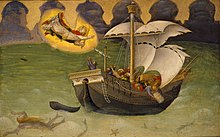Gentile da Fabriano
Gentile da Fabriano (actually Gentile di Nicolò Massio , * around 1370 or around 1385 in Fabriano ; † August 1, 1427 in Rome ) was an Italian late Gothic painter , of whom Michelangelo said his name was similar. He is also one of the main representatives of the courtly style around 1400 in Italy.
resume
Gentile da Fabriano was probably a student of Allegretto Nuzi . Towards the end of the century he initially worked in his hometown. In 1409 he was commissioned to decorate the Doge's Palace in Venice with frescoes (completed by Pisanello ). Later (between 1414-19) he worked in Brescia for Pandolfo III. Malatesta (ca. 1414-20) and frescoed there's chapel in the Broletto, Palazzo Comunale (not received), then he went to Florence, where he worked in the painters guild on 21 November 1422 as a citizen of the city Arte dei Medici e Speziali was taken and received a lot of attention from his painter colleagues u. a. Masolino and Fra Angelico as well as Masaccio. From 1425–27 in Siena he worked on a picture of the Madonna ( Madonna dei Notai , not preserved), then in Orvieto ( Quaratesi polyptych , central panel today in the National Gallery in London) and finally in Rome , where he completed his last work (in the 17th century . destroyed).
His most important panel painting and at the same time a key work in the history of painting is the Adoration of the Magi for the chapel of the wealthy Strozzi family of bankers in the church of Santa Trinità in Florence (now the Uffizi) from 1423. Here Gentile combined naive narrative joy with courtly elegance and richness of detail ; The sculptural and realistic design of the figures is characteristic of the turn from the late Gothic to the Renaissance .
Equally characteristic are the scenes from the life of St. Nicholas of Bari ( Predellata panels of the Quaratesi polyptych, Orvieto, around 1425), which is similar in style to that of Masolino . Around 1426 he followed the request of Pope Martin V and began a cycle in the Church of San Giovanni in Laterano in Rome with frescoes from the life of John the Baptist and in the spaces between the windows with figures of prophets (also completed by Pisanello). The only remaining fresco from him is in Orvieto Cathedral . There are very few works by Gentile outside of Italy.
His mostly elegant style had a great influence on the Florentine painters in the following years and formed the counterpart to the sparse realism that Masaccio cultivated.
Gentile da Fabriano was the first in a line of brilliant Umbrian painters and the most important Italian exponent of what is known as the “ International Gothic ”. His students included such important painters as Pisanello and Jacopo Bellini .
Selection of works
- Coronation of Mary, polyptych from Valle Romita near Fabriano (around 1400, Pinacoteca di Brera, Milan)
- Mary with the Child, Saints Catherine and Nicholas and the founder , around 1390–95, wood, 131 × 113 cm. (Berlin, State Museums, Picture Gallery)
- Madonna Enthroned with Child and Angels, around 1410, wood, 96.8 × 59 cm. (Perugia, Galleria Nazionale dell'Umbria)
- Mary with Child, around 1415, wood, 60 × 45 cm. (Pisa, Museo Nazionale di San Matteo)
- Adoration of the Magi, signed and dated May 1423, wood, overall size: 182 × 227 cm, part of the Pala Strozzi. (Florence, Uffizi Gallery)
- Mary with Child, 1427, wood, 110.4 × 66.3 cm. (Velletri, Museo Diocesano)
- Madonna and Child, 1425, fresco, 225 × 125 cm. (Orvieto, cathedral)
literature
- Christina Posselt (ed.) Giorgio Vasari . The life of Masolino, Masaccio, Gentile da Fabriano and Pisanello. Klaus Wagenbach Verlag, Berlin 2011. ISBN 978-3-8031-5052-3 .
- Gentile da Fabriano e l'altro rinascimento , a cura di Laura Laureati, Lorenza Mochi Onori, Milan: Electa 2006 ISBN 88-370-4553-0
- Gentile da Fabriano. Studi e ricerche , a cura di Andrea De Marchi, Laura Laureati, Lorenza Mochi Onori, Milan: Electa 2006 ISBN 88-370-4156-X
- Friedrich Wilhelm Bautz : Gentile da Fabriano. In: Biographisch-Bibliographisches Kirchenlexikon (BBKL). Volume 2, Bautz, Hamm 1990, ISBN 3-88309-032-8 , Sp. 207.
Individual evidence
- ↑ Christina Posselt (ed.): Giorgio Vasari . The life of Masolino, Masaccio, Gentile da Fabriano and Pisanello. Klaus Wagenbach, Berlin 2011, p. 58 .
Web links
- Works by Gentile da Fabriano at Zeno.org .
- Biography, work gallery, bibliography at Fabriano storica Italian
| personal data | |
|---|---|
| SURNAME | Gentile da Fabriano |
| ALTERNATIVE NAMES | Gentile di Nicolò Massio; Gentile di Niccolò di Giovanni Massi |
| BRIEF DESCRIPTION | Italian painter |
| DATE OF BIRTH | around 1370 or around 1385 |
| PLACE OF BIRTH | Fabriano |
| DATE OF DEATH | August 1, 1427 |
| Place of death | Rome |


